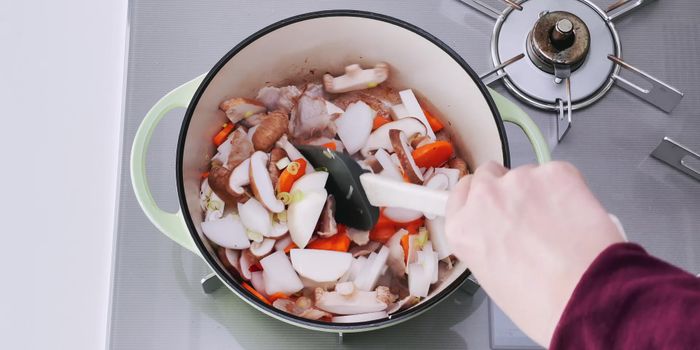Tonjiru, a hearty and deeply satisfying Japanese stew, is the perfect comfort food for chilly evenings. This rustic dish boasts a simple elegance, showcasing the natural sweetness of seasonal vegetables and the richness of pork. Its versatility allows for endless customization; feel free to experiment with your favorite root vegetables and greens. The beauty of Tonjiru lies in its approachable nature – even novice cooks can achieve delicious results with minimal effort. The warming broth, infused with the subtle umami of dashi, is both nourishing and incredibly flavorful.
This simple yet profound stew is a testament to the Japanese philosophy of appreciating fresh, seasonal ingredients. Ready to experience the comforting warmth of authentic Tonjiru? Let's dive into the step-by-step process, guiding you through every delicious stage of creating this beloved Japanese classic.
Tools Needed
- Heavy-bottomed pot
- Knife
- Cutting board
- Skimmer or spoon
Ingredients
- Thinly sliced pork jowl: 260g
- Tarō: 100g
- Shirataki noodles: 200g
- Carrots: 90g
- Daikon radish: 150g
- Burdock (Gobo): 90g
- Vinegar: 1 tablespoon
- Shiitake mushrooms: 90g
- Scallions: a few
- Japanese Dashi stock: 5 cups
- Yellow Miso paste: ¾ cup
- Mirin: 2 tablespoons
- Cooking oil
Step-by-Step Instructions
Step 1. Sear the Pork and Sauté Vegetables
- Heat a heavy-bottomed pot over medium-high heat. Add a splash of oil and add the pork, spreading it evenly. Fry undisturbed until browned on one side, then stir and brown the other side.
- Add daikon, taro, carrots, and scallions. Stir-fry until a brown fond forms on the bottom of the pot (approx. 2 minutes).


Step 2. Deglaze and Add Broth
- Deglaze the pot with mirin, allowing the alcohol to burn off.
- Add dashi stock, washed and drained burdock, and chopped shirataki noodles. Bring to a rolling boil over high heat. Skim off any foam that rises to the surface.


Step 3. Simmer and Season
- Reduce heat to a bare simmer. Add miso paste.
- Simmer uncovered until vegetables and meat are tender (20-30 minutes).


Step 4. Serve and Garnish
- Serve in bowls, garnished with sliced scallion greens and optional shichimi togarashi (chili pepper flakes).

Read more: Vegan Braised Lotus Root (Yeongeun Jorim): Easy Korean Recipe
Tips
- Use a cut of pork with lots of fat and connective tissue for tenderness.
- Soak burdock in acidified water (water + vinegar) to prevent oxidation. Rinse before using.
- Chop shirataki noodles to prevent tangling.
- Add miso paste towards the end of cooking for tonjiru, unlike miso soup.
- Adjust miso quantity based on saltiness; taste and add more if needed.
- Feel free to substitute other root vegetables or even protein sources.
Nutrition
- N/A
FAQs
1. Can I use different types of pork for Tonjiru?
Yes! Pork belly is traditional, but you can also use pork shoulder, loin, or even sausages for a different flavor profile.
2. What can I do if I don't have dashi?
A simple substitute is to use chicken or vegetable broth. Add a pinch of kombu (kelp) for a similar umami flavor if you have it.
Enjoy your delicious bowl of Tonjiru – a perfect blend of savory pork and sweet vegetables. This comforting stew is a testament to the simplicity and deliciousness of Japanese home cooking. Now, gather your family and friends and savor the warmth of this traditional Japanese delight!
